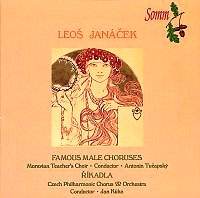Somm has dug into the
archives to return to the catalogue
a pretty much self-recommending disc,
the bulk of which is sung by the Moravian
Teachers’ Choir in a 1969 traversal
of some of Janáček’s
greatest male choruses. The Moravian
Teachers’ Choir, the international name
for the Choir of the Association of
Moravian Teachers, was founded in 1903
by Ferdinand Vlach and was well known
to Janáček. Tucapsky, known better
now perhaps as a composer of
distinction and a British resident,
conducted them from 1959-69 and this
may well have been his final recording
with the choir he’d conducted for a
decade.
Of the choruses set
some are on folk texts or more purely
romantic ones. The second here, Coz
ta nase briza (Our Birch tree) was
written by the Czech writer and Smetana’s
librettist Eliska Krasnohorska whilst
Klekanica is on a dialect text
– and dedicated to this choir, by the
way. Ceska legie (The Czech Legion)
is a nationalist epic celebrating the
establishment of Czechoslovakia in 1918.
Maybe surprisingly the text of Potulny
silence
(The Wandering Madman) is derived from
Tagore, whom Graham Melville-Mason’s
elucidatory notes remind us, Janáček
had heard in Prague in 1921. Kantor
Halfar is a not so coded political
protest against German authoritarianism,
oppression and the suppression of the
Czech language – and Sedmdesat tisic
still more of a political statement.
Whether epic, romantic, theatrico-dramatic,
dialect or philosophical these settings
make particular and significant demands
on a choir. The demands of characterisation
co-exist with those of technique and
expression. The Choir’s capacities in
these respects are truly remarkable.
The B Flats in the second of the choruses
are perfectly even and sustained and
they negotiate the, at first, simple
but increasingly complex freedoms and
"speech song" setting of Rozlouceni
with staggering finesse and technical
address. The declamatory complexity
and metrical complications of Ceska
legie with its varieties of mood,
tempo and sonority are conveyed with
the highest possible skill. The compass
of the choir is even across the range,
from head voice to the vertiginous Slavic
basses; single voices emerge from the
mass with fervent musicality and there
is a real sense of theatrical, sometimes
almost operatic, engagement with the
source material. Tucapsky encourages
dynamism and lyricism to flourish; his
guidance of the many varied complex
rhythmic effects is a testament both
to his skill and the sophistication
and understanding of the Moravian Teachers’
Choir.
Rikadla, the
nursery rhymes, come from the final
years of Janáček’s
life and were inspired by cartoons in
one of the composer’s favourite newspapers
and one to which he had contributed
his fare share of journalism over the
years. The work thus dates from around
the time of the composition of Mladi
and was originally
written for smaller forces, with Janáček
enlarging the piece later in 1925, after
it was first performed, for Chamber
Choir and ten instruments. These are
deft and amusing little sketches with
characterful contributions from a contingent
of the Czech Philharmonic. The
recording still sounds splendid and
there’s only one cause for complaint;
texts of four of the male choruses have
been omitted to save space. Not a good
idea. Otherwise an unalloyed pleasure.
Jonathan Woolf
